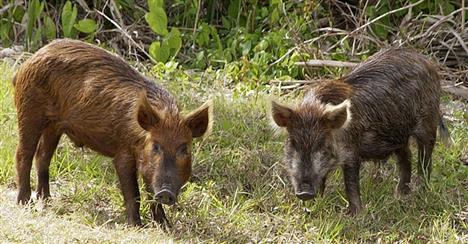Feral swine still causing significant damage to timberlands in Arkansas
by March 1, 2023 9:25 am 1,348 views

Feral swine causes more than $1.5 billion in damage to agriculture fields around the country each year. In Arkansas, it is estimated that the damage is about $19 million annually.
Damage to croplands has been well-documented in recent years, but there is less data available when it comes to feral hog damage in timberland areas.
Nana Tian, a forest economics researcher for the Arkansas Forest Resources Center, is part of an effort to change that dynamic.
The Arkansas Forest Resources Center in Monticello recently led a multi-state survey of 4,500 landowners to gauge economic damage to croplands, forestlands, pasturelands/livestock and their combinations.
“We know feral swine can cause a lot of damage, but it was a little surprising to see so many forest landowners reporting damage,” said Tian.
Forest landowners usually do not monitor their forestland as regularly as cropland owners, but many forest landowners reported damage and were aware of the seriousness of feral swine damage.
The Arkansas Forest Resources Center is a partnership between the University of Arkansas System Division of Agriculture and the University of Arkansas at Monticello. Research is administered through the Division of Agriculture’s Arkansas Agricultural Experiment Station.
The recently published survey estimates feral swine damages over five years across all of Arkansas and Louisiana and 38 counties in east Texas.
The average amount of land owned by those surveyed was 200 acres. Forestland and timberland losses were estimated at $17 per acre in both Arkansas and Louisiana, and $12 per acre in east Texas for the five-year period.
“We wanted to understand more about what was happening to the small landowners because smaller landowners may face more limitations than larger landowners in technical and financial assistance,” Tian said. “We wanted to have more information from their side.”
Common swine damage to forest landowners includes girdling trees through rubbing and damaging roots by rooting and chewing. In the southern U.S., feral swine are also known to root up newly planted tree seedlings in plantations of both pines and hardwood species. Tian said they can severely affect trees and timber resources.
Soybean, corn, and rice fields are a buffet table for a sounder of swine — the social unit of feral hogs. One sounder can root up a pasture overnight. Larger swine can kill and eat newborn calves and vulnerable cows. Feral swine teach their young how to evade traps and can trick even the most seasoned hunters and trappers. They are a problem for ranchers, farmers, and even golf course and cemetery managers, said Becky McPeake, extension wildlife specialist with the University of Arkansas System Division of Agriculture.
McPeake serves on the Arkansas Department of Agriculture’s Feral Hog Eradication Task Force, which is a group of state and partner agencies dedicated to managing Arkansas’ feral swine problem.
There are more than 6 million feral swine in 35 states across the nation, including Hawaii, according to the U.S. Department of Agriculture. Most of the swine population was established in southern states, first introduced in Texas by early Spanish explorers over 300 years ago as a source of cured meat and lard for settlers, the report noted. Regarded as an invasive species, feral swine are in all 75 counties of Arkansas with a population of about 200,000.
According to the Arkansas Department of Agriculture’s Feral Hog Task Force, diseases of highest concern with feral swine include pseudorabies virus, swine brucellosis, swine influenza, African swine fever, classic swine fever, and foot and mouth disease.
Caution is given to hunters who harvest feral pigs, McPeake said, because swine brucellosis can infect people. Pseudorabies doesn’t harm people but can be deadly if infected meat is fed to hunting dogs. The other diseases listed are of “great concern to swine producers and the agriculture industry because of untold expense should it ever get into domestic pigs,” McPeake added.
The feral swine economic impact survey was conducted in 2021 and published in January 2023. The project was initiated by Tian with research partners Jianbang Gan, professor in the department of ecology and conservation biology at Texas A&M University’s College of Agriculture and Life Sciences; and Gordon Holley, professor in the School of Agricultural Sciences and Forestry at Louisiana Tech University.
The researchers obtained 361 survey responses from Arkansas, 319 from Louisiana and 226 from east Texas for an average valid response rate of 22.9% for the three states combined.
In addition to the forestland estimates, the survey estimates that landowners’ average agricultural cropland damage in the past five years was $28 per acre in both Arkansas and Louisiana and approximately $25 per acre in east Texas. The most reported feral swine damage to agricultural crops was to corn, soybeans, rice, wheat, hay, silage and forage crops.
The reported damage to pastureland was very similar in all three states at $11 per acre.
